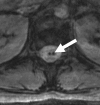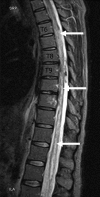Acute paraplegia after chiropraxis
- PMID: 20556441
- PMCID: PMC3111500
- DOI: 10.1007/s00586-010-1443-5
Acute paraplegia after chiropraxis
Abstract
Spinal manipulation is a form of back and other musculoskeletal pain treatment that often involves a high-velocity thrust, a technique in which the joints are adjusted rapidly. The main objective of chiropractors is to correct spinal malalignment and relieve the nerves, allowing them to function optimally (Ernst In: Expert Rev Neurother 7:1451-1452, 2007; Oppenheim et al. In: Spine J 5:660-666, 2005). The evidence for the effectiveness of this treatment based on randomized clinical trials still remains uncertain (Cassidy et al. In: Spine 33(4 suppl): S176-S183, 2008; Dupeyron et al. In: Ann Readapt Med Phys 46:33-40, 2003; Ernst et al. In: Expert Rev Neurother 7:1451-1452, 2007; Hurwitz et al. In: J Manipulative Physiol Ther 27:16-25, 2007; Thiel et al. In: Spine 32: 2375-2378, 2007). Several case reports and series have been focusing on the risks of chiropraxis, especially on the cervical spine, although the risk/benefit ratio for certain selected patients could be acceptable (Powell et al.In: Neurosurgery 33:73-78, 1993). We describe the case of a 45-year-old woman who suffered complete paraplegia shortly after a chiropractic maneuver in the thoracic spine. Dorsal CT showed a calcified disc herniation at the T8-T9 level and MRI revealed a diffuse spinal cord ischemia from T6 to the conus medullaris without spinal cord compression at the level of herniation. Despite a normal arteriography, authors suggest a vascular injury as the cause of the deficit.
Figures




Similar articles
-
Acute paraplegia following chiropractic therapy.J Clin Neurosci. 2006 Jun;13(5):578-81. doi: 10.1016/j.jocn.2005.03.041. J Clin Neurosci. 2006. PMID: 16769516 Review.
-
Thoracic intervertebral disc calcification and herniation in adults: a report of two cases.Eur Spine J. 2016 May;25 Suppl 1:118-23. doi: 10.1007/s00586-015-4214-5. Epub 2015 Sep 2. Eur Spine J. 2016. PMID: 26329651
-
Paraplegia due to thoracic disc herniation.Postgrad Med J. 1997 Jul;73(861):423-5. doi: 10.1136/pgmj.73.861.423. Postgrad Med J. 1997. PMID: 9338030 Free PMC article.
-
Non-traumatic acute paraplegia associated with cervical disc herniation: a case report.Surg Neurol. 1999 Aug;52(2):204-6; discussion 206-7. doi: 10.1016/s0090-3019(97)00422-9. Surg Neurol. 1999. PMID: 10447291
-
Spinal cord compression due to multivel thoracic disc herniation: surgical decompression using a "combined" approach. A case report and review of the literature.J Neurosurg Sci. 2000 Mar;44(1):53-9. J Neurosurg Sci. 2000. PMID: 10961498 Review.
Cited by
-
Spinal Cord Ischemia Related to Disc Herniation: Case Report and a Review of the Literature.Int Med Case Rep J. 2021 Jun 24;14:429-433. doi: 10.2147/IMCRJ.S316797. eCollection 2021. Int Med Case Rep J. 2021. PMID: 34211300 Free PMC article.
-
Spinal cord ischemia revealed by a Brown-Sequard syndrome and caused by a calcified thoracic disc extrusion with spontaneous regression: a case report and review of the literature.J Med Case Rep. 2023 Nov 29;17(1):510. doi: 10.1186/s13256-023-04208-1. J Med Case Rep. 2023. PMID: 38017566 Free PMC article. Review.
-
Safety of thrust joint manipulation in the thoracic spine: a systematic review.J Man Manip Ther. 2015 Jul;23(3):154-61. doi: 10.1179/2042618615Y.0000000012. J Man Manip Ther. 2015. PMID: 26309386 Free PMC article.
-
What are the risks of manual treatment of the spine? A scoping review for clinicians.Chiropr Man Therap. 2017 Dec 7;25:37. doi: 10.1186/s12998-017-0168-5. eCollection 2017. Chiropr Man Therap. 2017. PMID: 29234493 Free PMC article.
-
Thoracic adverse events following spinal manipulative therapy: a systematic review and narrative synthesis.J Man Manip Ther. 2020 Dec;28(5):275-286. doi: 10.1080/10669817.2020.1725277. Epub 2020 Mar 9. J Man Manip Ther. 2020. PMID: 32148185 Free PMC article.
References
-
- Dupeyron A, Vautravers P, Lecocq J, Isner-Horobeti ME. Complications following vertebral manipulation—a survey of a French region physicians. Ann Readapt Med Phys. 2003;46:33–40. - PubMed
Publication types
MeSH terms
LinkOut - more resources
Full Text Sources
Medical

